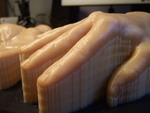![Spritam 3D printed tablet dissolving upon contact with water [Source: Aprecia]](https://fabbaloo.com/wp-content/uploads/2020/05/image-asset_img_5eb065bc1aa86.jpg)
Spritam 3D printed tablet dissolving upon contact with water [Source: Aprecia]
Interest in 3D printed pharmaceuticals continues to grow.
One of the major players in 3D printed pharmaceuticals is Ohio-based Aprecia. Founded way back in 2003, the company has leveraged a 3D printing process from MIT into a key technology for the company. They explain:
“Powder-liquid 3DP, a novel technology that forms objects layer by layer, was originally developed at the Massachusetts Institute of Technology (MIT) in the late 1980s as a rapid-prototyping technique. From 1993 to 2003, this work was expanded into the distinct areas of tissue engineering and pharmaceuticals. While 3DP technology rights were licensed for a diverse range of industrial fields, MIT’s 3DP process and its applications in the pharmaceutical industry are exclusively licensed to Aprecia.”
ZipDose 3D Printed
They’ve named their specific process “ZipDose”, which produces medicinal tablets with some interesting properties. They say it’s the “world’s first and only 3DP drug printing technology”, and introduced Spritam medication, made with ZipDose technology, several years ago. It was FDA-approved in 2015.
One of these interesting properties is that the tablets are not made using the traditional compression approach, and thus can be composed in different ways. For example, they can achieve high dosages within a single tablet that far exceed that of normal tablets. They say they can achieve 1000mg per tablet.
Another advantage is their water-soluble binder allows for a near-instantaneous dissolve after a “sip of water”. This allows patients to swallow pills far more easily, and in some patients it’s a critical capability. Their videos show tablets essentially falling apart upon being placed in water — amazing!
Medicine often tastes awful, but Aprecia’s technology allows something they call “taste masking”, which “allows the application of enhanced taste-masking techniques.”
ZipDose 3D Printing
How does their process work? It seems to be a combination of both powder and liquid materials.
A roller system disperses a thin layer of powder that is bound using selectively dropped liquid. This process repeats to gradually build up the tablet into its final form.
By building the tablet layer-by-layer, it’s theoretically possible to have different powders per layer, enabling some interesting possibilities.
Purdue Aprecia Partnership
Aprecia has built a “platform” for medicinal tablet production using a form of 3D printing. However, platforms are just that — a place where different applications are easily built. But what are the applications?
Aprecia works with clients to develop these applications, but recently the company has struck a deal with Purdue University to advance these concepts much further.
From the description in their press release, it appears that the two parties will work together on a variety of projects to develop new pharmaceutical applications using Aprecia’s technology, in “joint collaborations in research and discovery”.
Thus it’s not clear exactly what will be the outcome of this partnership. But that’s the best kind of venture: one where you can repeatedly experiment until you find something of interest.
Via Aprecia

